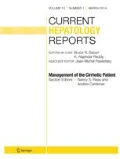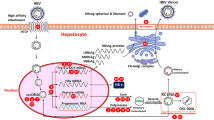Abstract
Purpose of Review
To provide a review and update of complementary and alternative medicine (CAM) approaches to the management of chronic hepatitis B, with particular emphasis upon traditional Chinese medicines (TCM).
Recent Findings
The major findings are as follows: (1) TCMs were better than interferons [IFN] in lowering serum HBeAg and normalizing serum ALT, and equivalent to IFN in clearing serum HBV DNA; (2) TCMs were equivalent to lamivudine [LAM] in lowering serum HBeAg, normalizing serum ALT, and clearing serum HBV DNA; (3) TCMs along with IFN or LAM significantly lowered serum HBeAg and improved the clearance of serum HBV DNA and the normalization of serum ALT, compared with IFN or LAM alone; (4) no serious adverse reactions of TCM were reported in all cited clinical trials. Although the composition of traditional medicines in the TCMs varied among RCTs, about 60% of the used herbs were homologous. Our major overarching conclusion was that TCMs seem effective as alternative remedies for patients with CHB. Other CAM approaches also are widely used, especially in east Asian countries, and there is limited evidence of benefit for some.
Summary
CHB continues to be a major health problem worldwide. Although nucleosides such as tenofovir and entecavir are highly effective at suppression of HBV replication, they are expensive and often beyond reach of patients, especially in resource-limited nations and regions. Many such patients will continue to rely upon CAM and TCM for management of their chronic hepatitis B infections. Additional carefully done, placebo-controlled prospective randomized trials of CAM and TCM in chronic hepatitis B should be performed.


Similar content being viewed by others
References
Papers of particular interest, published recently, have been highlighted as: • Of importance •• Of major importance
Zhang S, Wang F, Zhang Z. Current advances in the elimination of hepatitis B in China by 2030. Front Med. 2017;11(4):490–501.
Kovari H, Sabin CA, Ledergerber B, Ryom L, Worm SW, Smith C, et al. Antiretroviral drug-related liver mortality among HIV-positive persons in the absence of hepatitis B or C virus coinfection: the data collection on adverse events of anti-HIV drugs study. Clin Infect Dis. 2013;56(6):870–9.
Tsai DS, Huang MH, Chang YS, Li TC, Peng WH. The use of Chinese herbal medicines associated with reduced mortality in chronic hepatitis B patients receiving lamivudine treatment. J Ethnopharmacol. 2015;174:161–7.
• Wong VW, Law MY, Hui AY, Lo AO, Li CY, Soo MT, et al. A hospital clinic-based survey on traditional Chinese medicine usage among chronic hepatitis B patients. Complement Ther Med. 2005;13(3):175–82. Auseful survey from PR China.
•• Zhang L, Wang G, Hou W, Li P, Dulin A, Bonkovsky HL. Contemporary clinical research of traditional Chinese medicines for chronic hepatitis B in China: an analytical review. Hepatology. 2010;51(2):690–8. Still the largest and most thorough review of the subject.
Zhang W, Li Y, Yang L, Zhou B, Chen KL, Meng WJ, et al. Knockdown of MMP-7 inhibits cell proliferation and enhances sensitivity to 5-Fluorouracil and X-ray irradiation in colon cancer cells. Clin Exp Med. 2014 Feb;14(1):99–106.
•• Rambaldi A, Jacobs BP, Iaquinto G, Gluud C. Milk thistle for alcoholic and/or hepatitis B or C liver diseases--a systematic cochrane hepato-biliary group review with meta-analyses of randomized clinical trials. Am J Gastroenterol. 2005;100(11):2583–91. A Cochrane review of milk thistle, which continues to be widely used by persons with liver diseases.
Vargas-Mendoza N, Madrigal-Santillan E, Morales-Gonzalez A, Esquivel-Soto J, Esquivel-Chirino C, Garcia-Luna YG-RM, et al. Hepatoprotective effect of silymarin. World J Hepatol. 2014;6(3):144–9.
• Wei ZQ, Zhang YH, Ke CZ, Chen HX, Ren P, He YL, et al. Curcumin inhibits hepatitis B virus infection by down-regulating cccDNA-bound histone acetylation. World J Gastroenterol. 2017;23(34):6252–60. A recent publication on a possible mechanism of action of curcumin.
Farzaei MH, Zobeiri M, Parvizi F, El-Senduny FF, Marmouzi I, Coy-Barrera E, et al. Curcumin in liver diseases: a systematic review of the cellular mechanisms of oxidative stress and clinical perspective. Nutrients. 2018; 10(7):855.
Marquardt JU, Gomez-Quiroz L, Arreguin Camacho LO, Pinna F, Lee YH, Kitade M, et al. Curcumin effectively inhibits oncogenic NF-kappaB signaling and restrains stemness features in liver cancer. J Hepatol. 2015;63(3):661–9.
•• Chen WL, Lin CH, Huang CC, Tsai CI. Chinese herbal medicine reduces acute hepatitis exacerbation in patients with hepatitis B virus infection: a case-control study in Taiwan. Complement Ther Med. 2019;42:248–54. Recent study from Taiwan that showed evidence of benefit of TCM.
• Ye YA, Li XK, Zhou DQ, Chi XL, Li Q, Wang L, et al. Chinese herbal medicine combined with entecavir for HBeAg positive chronic hepatitis B: study protocol for a multi-center, double-blind randomized-controlled trial. Chin J Integr Med. 2018;24(9):653–60. Recent study with better design than many.
• Li H, Ye Z, Gao X, Zhang L, Yao X, Gu J, et al. Diwu Yanggan capsule improving liver histological response for patients with HBeAg-negative chronic hepatitis B: a randomized controlled clinical trial. Am J Transl Res. 2018;10(5):1511–21. Another recent trial with good design.
•• Zhang Y, Wang YT, Luo JX, Hu XY, Yang F, Lin W, et al. Effect of WSP, a Chinese herbal formula, on Th17/Treg ratio and HBeAg seroconversion in telbivudine-treated HBeAg-positive chronic hepatitis B patients with high baseline ALT levels (20–30 times the ULN). Evid Based Complement Alternat Med. 2019;2019:7260369. Recent paper with measures of T cell responses, as well as clinical responses.
Tsai TY, Livneh H, Hung TH, Lin IH, Lu MC, Yeh CC. Associations between prescribed Chinese herbal medicine and risk of hepatocellular carcinoma in patients with chronic hepatitis B: a nationwide population-based cohort study. BMJ Open. 2017;7(1):e014571.
Han M, Lai L, Li XX, Zhao NQ, Li J, Xia Y, et al. An overview of the randomized placebo-controlled trials of Chinese herbal medicine formula granules. Evid Based Complement Alternat Med. 2019;2019:6486293.
• Choi SH, Yang KJ, Lee DS. Effects of complementary combination therapy of Korean red ginseng and antiviral agents in chronic hepatitis B. J Altern Complement Med. 2016;22(12):964–9. Results of effect of Korean red ginseng, which is widely used in Korea and China.
Hsu CH, Hwang KC, Chiang YH, Chou P. The mushroom Agaricus blazei Murill extract normalizes liver function in patients with chronic hepatitis B. J Altern Complement Med. 2008;14(3):299–301.
Jacob JR, Korba BE, You JE, Tennant BC, Kim YH. Korean medicinal plant extracts exhibit antiviral potency against viral hepatitis. J Altern Complement Med. 2004;10(6):1019–26.
• Li B, Wang Y, Shen F, Wu M, Li Y, Fang Z, et al. Identification of retinoic acid receptor agonists as potent hepatitis B virus inhibitors via a drug repurposing screen. Antimicrob Agents Chemother. 2018;62(12): e00465-18. Results of recent drug screen that identified RAR agonists as promsing agents for HBV.
Xia JF, Gao JJ, Inagaki Y, Kokudo N, Nakata M, Tang W. Flavonoids as potential anti-hepatocellular carcinoma agents: recent approaches using HepG2 cell line. Drug Discov Ther. 2013;7(1):1–8.
Xia J, Inagaki Y, Song P, Sawakami T, Kokudo N, Hasegawa K, et al. Advance in studies on traditional Chinese medicines to treat infection with the hepatitis B virus and hepatitis C virus. Biosci Trends. 2016;10(5):327–36.
• Liem KS, Yim C, Ying TD, Zanjir WR, Fung S, Wong DK, et al. Prevalence and predictors of complementary and alternative medicine modalities in patients with chronic hepatitis B. Liver Int. 2019;Open Access. https://doi.org/10.1111/liv.14105. Recent survey that emphasizes frequent use of CAM in patients with CHB.
Erlichman J, Salam A, Haber BA. Use of complementary and alternative medicine in pediatric chronic viral hepatitis. J Pediatr Gastroenterol Nutr. 2010 Apr;50(4):417–21.
•• Shen T, Liu Y, Shang J, Xie Q, Li J, Yan M, et al. Incidence and etiology of drug-induced liver injury in mainland China. Gastroenterology 2019; 156:2230–2241. Recent report that stresses high frequency of drug-induced liver injury due to TCM in mainland China.
Xu LW, Jia M, Salchow R, Kentsch M, Cui XJ, Deng HY, et al. Efficacy and side effects of chinese herbal medicine for menopausal symptoms: a critical review. Evid Based Complement Alternat Med. 2012;2012:568106.
Acknowledgments
Supported in part by cooperative agreements with the US National Institutes of Health, which provided support for Dr. Bonkovsky: U01 DK065201 and U54 DK083909.
Author information
Authors and Affiliations
Corresponding author
Ethics declarations
Conflict of Interest
Drs. Liang, Li, Tan, Wang, and Bonkovsky declare no conflicts of interest relevant to this work.
Human and Animal Rights and Informed Consent
This article does not contain any studies with human or animal subjects performed by any of the authors.
Additional information
Publisher’s Note
Springer Nature remains neutral with regard to jurisdictional claims in published maps and institutional affiliations.
This article is part of the Topical Collection on Hepatitis B
Rights and permissions
About this article
Cite this article
Wang, G., Liang, P., Li, P. et al. The Role of Traditional Chinese Medicines (TCM) and Other Complementary and Alternative Medicines (CAM) in the Management of Chronic Hepatitis B. Curr Hepatology Rep 18, 316–321 (2019). https://doi.org/10.1007/s11901-019-00480-2
Published:
Issue Date:
DOI: https://doi.org/10.1007/s11901-019-00480-2




